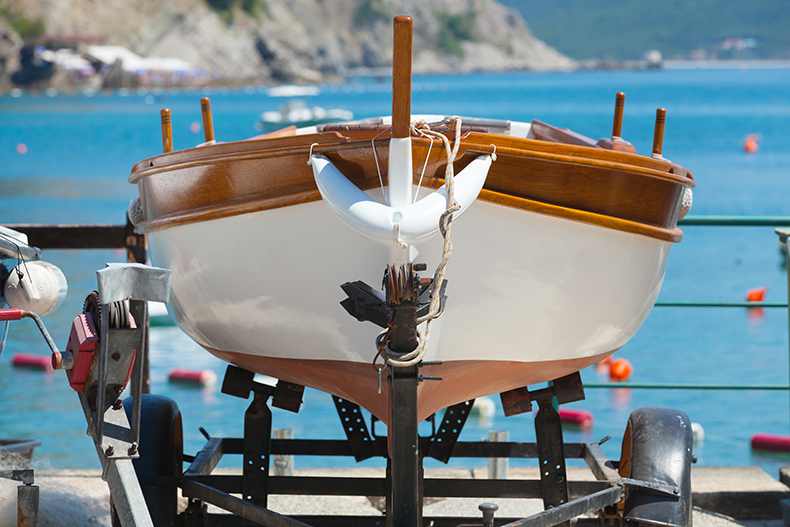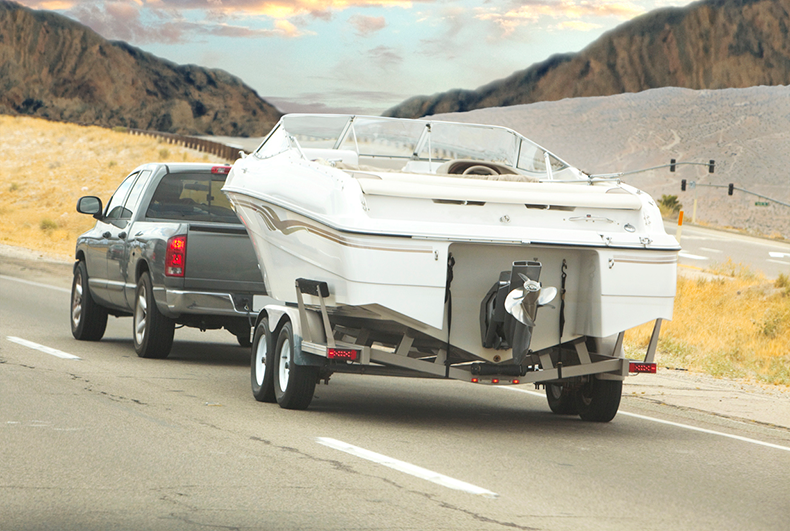Boat ownership elicits all kinds of emotions in people. Not the least of which is how polarizing boat ownership can be. They are wind-in-your-hair fun. They bring friends and family together. They also are expensive and anything but fun to maintain. As investments go, they defy logic.
And yet, an estimated 100 million Americans go boating each year.
Segments that drove boat market growth in 2022 included entry-level boats such as personal watercraft, freshwater aluminum, fiberglass fishing boats, and pontoon boats less than 26 feet.
Boat Transport
One of the biggest challenges of watercraft ownership is boat transport, especially at long distances, as an enthusiast or boat dealer.
Year in and year out, uShip continues to be one of the most popular places to get watercraft moved. Here’s a breakdown of boat shipments within the U.S., how much it costs on average, distance traveled, days in transit, and more.
What types of watercraft get shipped?
If it propels through water, chances are it’s shipped through uShip. Since 2020, 6,000 boats per year get hauled on uShip, primarily during “boat season” between Memorial Day and Labor Day. The types of boats shipped include power boats (recreational, pontoon, and fishing boats), sailboats, and personal watercraft (including jet skis, kayaks, and canoes).
Since 2020, powerboats have made up 77% of the watercraft shipment listings on uShip, followed by personal watercraft at 15% and sailboats at 6%.
How much does it cost to transport a boat or watercraft?
Like most things, boat transport has been more expensive since 2020. On uShip, the average cost of boat transport was $1,270 in 2020, $1,462 in 2021, and $1,883 in 2022. That’s a 48% increase from 2020 to 2022.
The time when it cost the least to ship a boat ($1,229) was just as the pandemic began in March 2020. It costs the most to ship a boat ($2,021) in Spring 2022.
What does it cost to transport a powerboat?
The average cost to transport a powerboat on uShip was $1,768 between 2020-2022. In 2020 the cost was $1,069 but doubled to $2,131 in 2021. That rate dipped slightly in 2022, decreasing from $2,131 to $2,104 per shipment.
What does it cost to transport a sailboat?
The average cost to transport a sailboat on uShip was $1,813 between 2020-2022. In 2020 the cost was $1,528, which jumped 12.5% the following year to $1,719 in 2021. That rate jumped again in 2022, increasing 27.5% from $1,719 to $2,192 per shipment.

What does it cost to transport a jet ski?
The average cost to transport a personal watercraft like a jet ski on uShip between 2020-2022 was $753. In 2020 the cost was $631, which jumped 17% to $737 in 2021. That rate jumped again in 2022, increasing 20% from $737 to $889 per shipment.

The average cost to ship various types of watercraft
| Year | Jet Skis | Powerboats | Sailboats |
|---|---|---|---|
| 2020 | $631 | $1,069 | $1,528 |
| 2021 | $737 | $2,131 | $1,719 |
| 2022 | $889 | $2,104 | $2,192 |
Does it save money to ship a watercraft trailered or untrailered?
Shipping a non-trailered boat is less expensive – by about 50%. In 2022, the average cost to transport a non-trailed boat was $1,151, while a trailered boat cost an average of $2,102 to ship within the U.S.
The combination of the trailer and the boat simply weighs more and therefore costs more to ship.

Why is boat transport expensive?
Shipping a boat, whether a ski, fishing, or sailboat, takes skill, experience, and the right equipment. Watercraft are often prized possessions, so just no one should handle them.
In addition, the cost to ship anything (including boats) in 2022 increased dramatically due to inflationary pressures, record-high fuel costs, higher demand for truck parts, driver insurance spikes, and high labor and wages. All this raises the price tag for both business and consumer boat transport.
How do you keep boat transportion costs down?
What makes uShip unique is the competitive bidding process between transportation providers. When a business or consumer lists a watercraft on uShip, boat-hauling specialists compete for the business by placing bids.
In fact, since 2020, more than 457,000 bids have been placed on boat shipment listings, and 80% of the 91,000 boats listed on uShip during that time received at least two bids from service providers.
This competition not only gives shipping customers a choice but also allows the law of supply and demand to play itself out so customers know they aren’t overpaying for the service.
How do I find an experienced boat hauler?
Since 2020, over 17k transporters have shipped at least one boat on uShip. Further, each of the top 100 boat transporters has shipped at least 30 boats since 2020, and the top 20 have shipped nearly 100 boats apiece in that time frame.
That’s a lot of experience.
These transporters compete for business on uShip by bidding against each other. For both personal and business boat shippers, this not only keeps rates down but provides choice.
Q&A with Carriers
uShip’s Q&A feature is one way uShip helps shipping customers decide who they select for their boat transport. When a boat is listed for transport on uShip, transporters will often ask questions about the boat before bidding. This information allows them to provide as accurate of a quote as possible. It’s also an opportunity for shipping customers to interview the hauler. For example, shipping customers can ask what kind of equipment the transporter has or if they have experience shipping unique watercraft or boats with outboard motors.
Ratings & Reviews
uShip’s ratings and reviews complement the Q&A feature. The higher the score and rating, the better experience you as a shipping customer will likely receive. Each transporter’s service history is publicly available on uShip, making it easy to do your homework when making an educated decision.
uShip Protection Plan
Boat shippers can safeguard their shipments through the uShip Protection Plan, a simple way to protect high-value boat shipments against unexpected loss or damage. In fact, since 2020, nearly half of the boat shippers on uShip have protected their shipments.
There’s often confusion about which party is responsible if an incident occurs. A uShip survey found 30% of business shippers assumed their carrier’s insurance would cover any damages. If your transporter carries its own protection, there’s a chance that some damages could be covered. However, coverage varies and isn’t guaranteed.
For peace of mind, uShip recommends its all-risk, comprehensive protection plan that covers shipments at a competitive rate.
Who ships boats?
On uShip, personal boat owners such as on-the-water enthusiasts, families, and restorers make up 80% of the shipping audience. In contrast, businesses such as boat dealers, boat brokers, and boat repair shops make up the remaining 20%. Between both groups, power boats ship approximately 80% of the time.
How far do boats get shipped?
Since 2020, most U.S. boats shipped through uShip travel between 1000-1500 miles with an average of eight days in transit. That’s followed by boats traveling 500-1000 miles, taking an average of six days in transit. The chart below shows a full breakdown of miles traveled and days on the road.
| Miles | Listings | Avg. Bid | Transit Days |
|---|---|---|---|
| 0-500 | 19,473 | $608 | 5 |
| 501-1000 | 22,651 | $1,045 | 6 |
| 1001-1500 | 25,123 | $1,564 | 8 |
| 1501-2000 | 8,824 | $2,013 | 9 |
Where are boats shipped the most?
In a word: Florida. No surprise that more boats travel to, from, and within Florida than any other state. While the top 10 states for boat shipments have aquatic geography and relatively high population density, Florida leaves the rest in its wake. Over 2.5 times as many boats ship FROM Florida as the second state (California), while 2.5x as many boats LEAVE Florida as the second state (Texas).
The only land-locked state to crack the top 10 in boat destinations is Arizona (No. 10).
One surprising fact: the state with the most boats per capita – Minnesota at 143.6 boats per thousand people – did not make the Top 10 list for boat shipment originations or destinations on uShip.

What are the top places to sell or buy a boat?
Those wanting to get into boats, be it for recreation or fishing, are finding the most affordable way in is by buying a pre-owned watercraft. Used boat sales are outpacing new boat sales 2-to-1. And an estimated 1.15 million pre-owned boats were sold in 2021, up 9.2 percent over 2020.
So if you want to buy or sell a used watercraft, where do you go? Often word of mouth around your marina or among friends can be a place to start, but to truly reach a buying audience and fetch the best price (whether buying or selling), most sales today originate online.
Here’s a short list of options:
Craigslist: Not a lot of bells and whistles here, but it’s effective and gets a lot of eyeballs. If you’re selling, know that the price range (in the thousands) will likely attract scammers and legit buyers. Before jumping in here, get familiar with common Craigslist scams and ways to stay safe when meeting third parties.
eBay: Compared to Craigslist, eBay is the safer bet for buyer and seller engagement. Rely on feedback scores and past reviews to gut-check the legitimacy of the sale. Buyer protection is often included in purchases like this, although final sales may occur off eBay. Be aware of eBay Motors’ listing and selling fees and any processing fees.
Facebook Marketplace: A relatively new kid in town compared to Craigslist and eBay. Often good to attract local buyers who are also on Facebook and looking to buy. Like Craigslist, scammers frequent Facebook Marketplace, so read up on common scams.
Boat Trader: This site is known for serious boaters, so it’s important to know your stuff, whether buying or selling. Boat Trader doesn’t take a commission for private boat sales; there’s just a $59 listing fee up front for any boat size.
Boats.com: Like Boat Trader, Boats.com is a paid classifieds site that has an upfront fee when selling your boat. Package price varies depending on the exposure you want and how long you want to list it. The site offers up tips for preventing and avoiding scams as well.
Broker: If you want to leave buying or selling in the hands of a professional, boat brokers can handle it for you – for a fee. Generally speaking, a brokers take is a 10% commission. If you are selling a yacht, brokers have the ability to reach deep into that market of buyers. For some, this is worth it, but it’s not for everyone.
And remember, no matter how you buy or sell a boat, shipping will likely be involved. If it’s transacted at a distance, be sure to remember to add boat transport cost into the total price.




